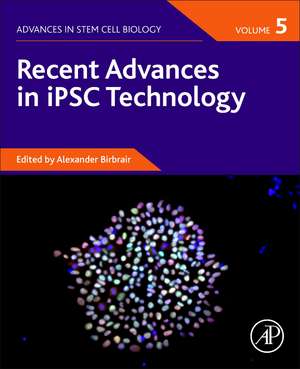Recent Advances in iPSC Technology: Advances in Stem Cell Biology
Editat de Alexander Birbrairen Limba Engleză Paperback – 7 apr 2021
- Provides overview of the fast-moving field of induced pluripotent stem cell technology, regenerative medicine, and therapeutics
- Covers the following topics: iPSCs for modeling the cardiovascular toxicities of anticancer therapies, iPSC differentiation through the lens of the non-coding genome, modeling of blood-brain barrier with iPSCs, mathematical modelling of iPSCs, iPSCs to study human brain evolution, self-renewal in iPSCs, differences and similarities between iPSCs and embryonic stem cells, and more
- Contributed by world-renown experts in the field
Din seria Advances in Stem Cell Biology
- 28%
 Preț: 797.64 lei
Preț: 797.64 lei - 27%
 Preț: 782.05 lei
Preț: 782.05 lei - 23%
 Preț: 796.11 lei
Preț: 796.11 lei - 24%
 Preț: 785.01 lei
Preț: 785.01 lei - 22%
 Preț: 801.17 lei
Preț: 801.17 lei - 22%
 Preț: 798.16 lei
Preț: 798.16 lei - 22%
 Preț: 798.68 lei
Preț: 798.68 lei - 9%
 Preț: 800.27 lei
Preț: 800.27 lei - 9%
 Preț: 797.78 lei
Preț: 797.78 lei - 23%
 Preț: 797.52 lei
Preț: 797.52 lei - 22%
 Preț: 798.16 lei
Preț: 798.16 lei - 23%
 Preț: 801.44 lei
Preț: 801.44 lei - 23%
 Preț: 796.37 lei
Preț: 796.37 lei - 22%
 Preț: 798.02 lei
Preț: 798.02 lei - 22%
 Preț: 801.55 lei
Preț: 801.55 lei - 9%
 Preț: 801.36 lei
Preț: 801.36 lei
Preț: 786.68 lei
Preț vechi: 1029.70 lei
-24% Nou
Puncte Express: 1180
Preț estimativ în valută:
150.53€ • 164.03$ • 126.84£
150.53€ • 164.03$ • 126.84£
Carte tipărită la comandă
Livrare economică 16-30 aprilie
Preluare comenzi: 021 569.72.76
Specificații
ISBN-13: 9780128222317
ISBN-10: 012822231X
Pagini: 334
Ilustrații: 60 illustrations (40 in full color)
Dimensiuni: 191 x 235 x 25 mm
Editura: ELSEVIER SCIENCE
Seria Advances in Stem Cell Biology
ISBN-10: 012822231X
Pagini: 334
Ilustrații: 60 illustrations (40 in full color)
Dimensiuni: 191 x 235 x 25 mm
Editura: ELSEVIER SCIENCE
Seria Advances in Stem Cell Biology
Cuprins
1. Modeling the Cardiovascular Toxicities of Anticancer Therapies in the Era of Precision Medicine
2. Looking at Induced Pluripotent Stem Cell (iPSCs) Differentiation Through the Lens of The Non-Coding Genome
3. In Vitro Blood-Brain Barrier Model Derived from Human Ips Cells and Its Applications
4. The Progress in The Study of Reprogramming to Acquire the Features of Stem Cells In iPSCs and Cancers
5. An Introduction to The Mathematical Modelling of iPSCs
6. Use of iPSCs-Derived Brain Organoids to Study Human Brain Evolution
7. Self-Renewal in Induced Pluripotent Stem Cells
8. Strategies for iPSCs Expansion
9. An Overview of Reprogramming Approaches to Derive Integration-Free Induced Pluripotent Stem Cells for Prospective Biomedical Applications
10. Induced Pluripotent Stem Cells Versus Embryonic Stem Cells: A Comprehensive Overview of Differences and Similarities
2. Looking at Induced Pluripotent Stem Cell (iPSCs) Differentiation Through the Lens of The Non-Coding Genome
3. In Vitro Blood-Brain Barrier Model Derived from Human Ips Cells and Its Applications
4. The Progress in The Study of Reprogramming to Acquire the Features of Stem Cells In iPSCs and Cancers
5. An Introduction to The Mathematical Modelling of iPSCs
6. Use of iPSCs-Derived Brain Organoids to Study Human Brain Evolution
7. Self-Renewal in Induced Pluripotent Stem Cells
8. Strategies for iPSCs Expansion
9. An Overview of Reprogramming Approaches to Derive Integration-Free Induced Pluripotent Stem Cells for Prospective Biomedical Applications
10. Induced Pluripotent Stem Cells Versus Embryonic Stem Cells: A Comprehensive Overview of Differences and Similarities
